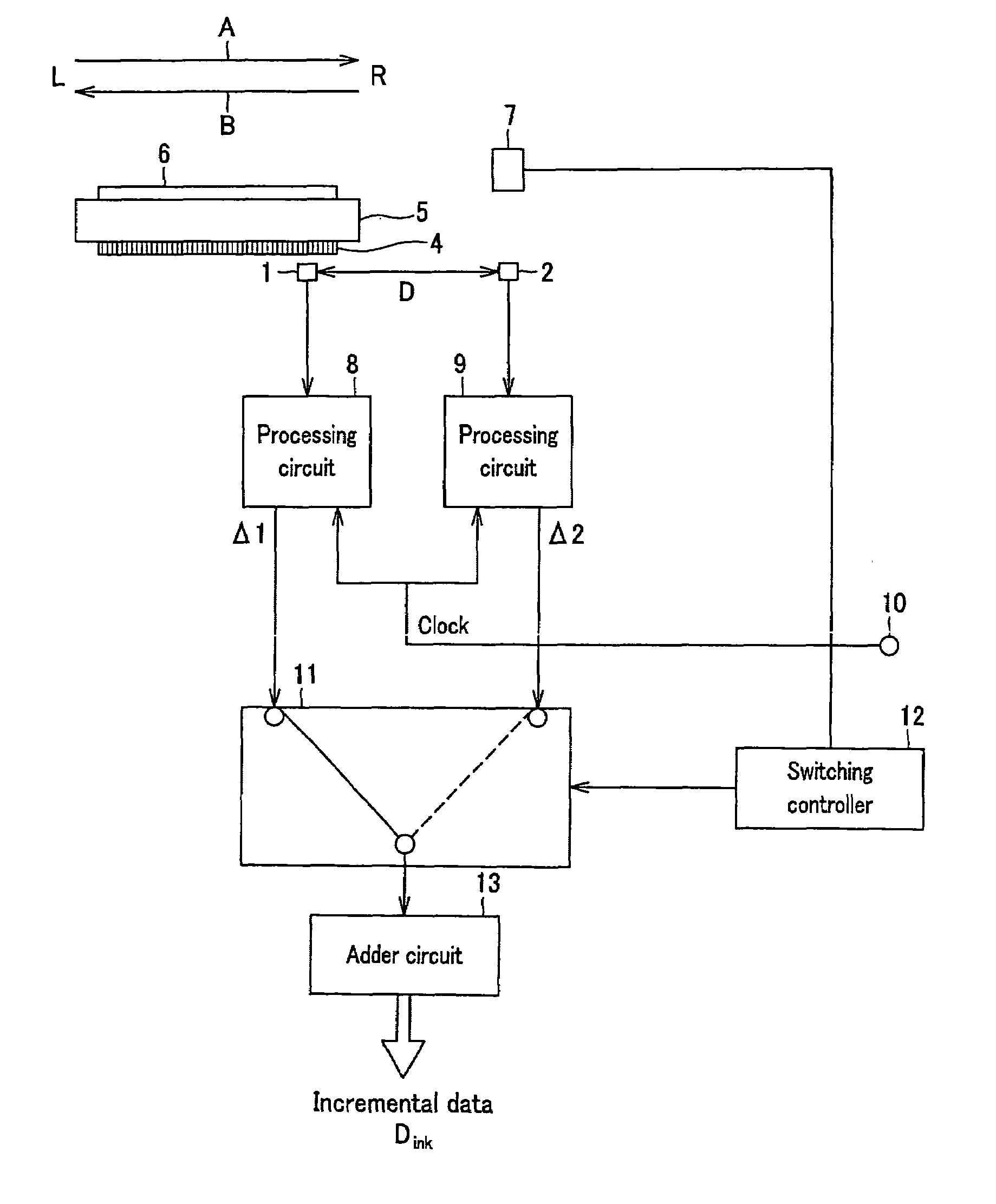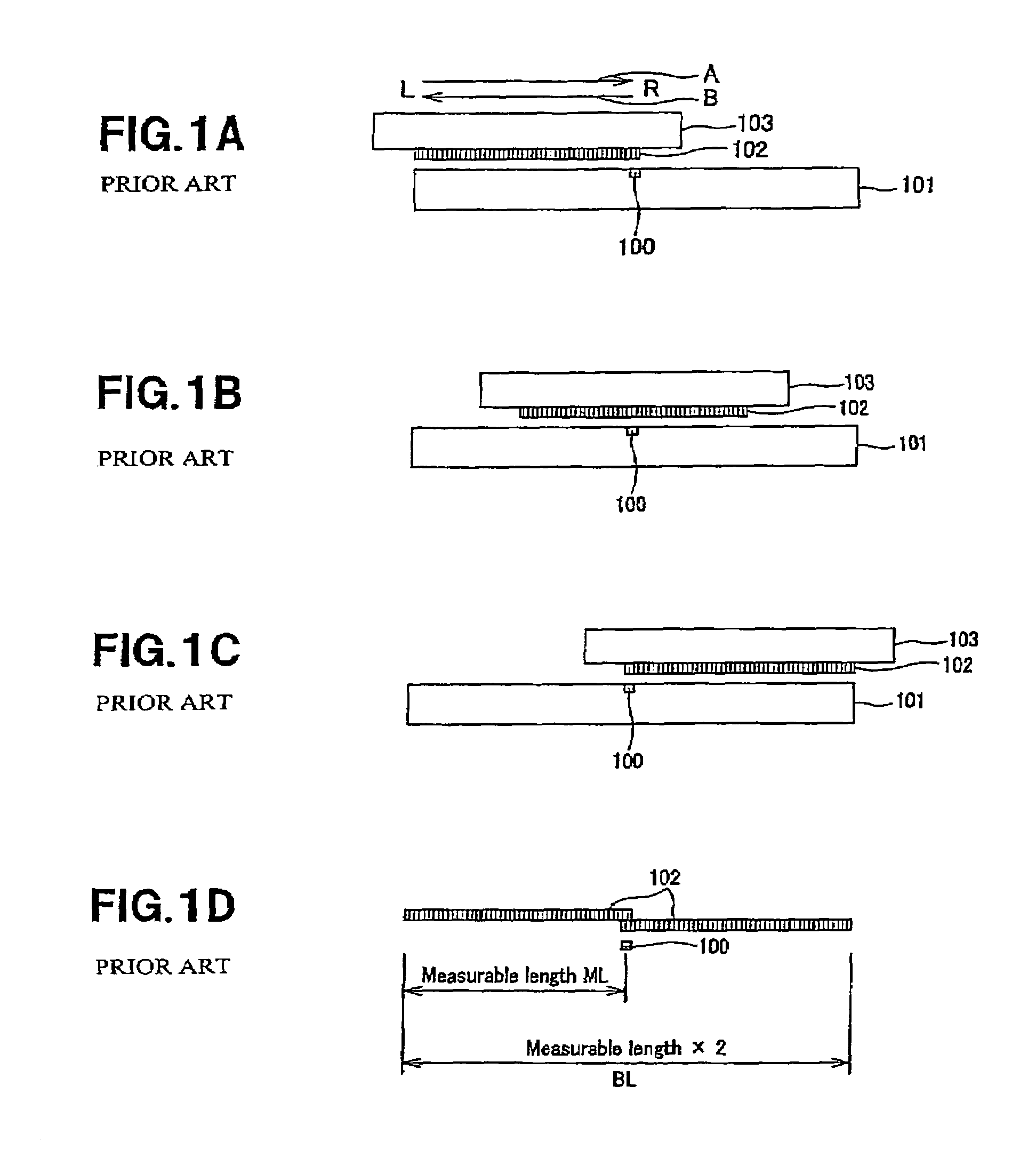Displacement detection apparatus
a technology for displacement detection and equipment, applied in the direction of counting objects on conveyors, program control, instruments, etc., can solve the problems of difficult to precisely mark graduations on a single scale, difficult to prepare a single long scale and arrange it on a table, etc., to achieve long measurable range, minimize errors, and long measurable range
- Summary
- Abstract
- Description
- Claims
- Application Information
AI Technical Summary
Benefits of technology
Problems solved by technology
Method used
Image
Examples
first embodiment
[0057]FIGS. 7A through 7C are schematic illustrations of the relative positions of the scale 4 and the heads 1 and 2 of the More specifically, FIG. 7A shows the left limit of the scale 4 and FIG. 7C shows the right limit of the scale 4. FIG. 7B shows a position of the scale 4 in which both the signal from the head 1 and the signal from the head 2 are effective. It will be appreciated that FIGS. 7A, 7B and 7C are respectively simplified versions of FIGS. 6A, 6B and 6C.
[0058]The gap separating the head 1 and the head 2 is made smaller than the length L of the scale 4 so that the differential value Δ1 and the differential value Δ2, which will be described in greater detail hereinafter, may be switched from one to the other in a situation as illustrated in FIG. 7B. Since the head 1 and the head 2 are displaceable relative to the scale 4, it is possible to detect periodic analog signals of a plurality of different types as a function of the graduations cut on the scale 4 at a predetermi...
second embodiment
[0123]FIG. 24 is a schematic illustration of the relative positions of the single scale 24 and the three heads 21, 22 and 23 of FIG. 22. Since the differential value Δ1, the differential value Δ2 and the differential value Δ3, which will be described in greater detail hereinafter, are selectively used, the two gaps separating any two adjacent ones of the three heads 21, 22 and 23 (the gap D1 between the head 21 and the head 22 and the gap D2 between the head 22 and the head 23) are made shorter than the length of the scale 24. Since the head 21, the head 22 and the head 23 are displaceable relative to the scale 24, it is possible to detect periodic analog signals of a plurality of different types as a function of the graduations cut on the scale 24 at a predetermined pitch. As pointed out earlier, a periodic analog signal as used herein may refer to a sine wave sin or a cosine wave cos. Alternatively, it may be a plurality of sine waves sin or cosine waves cos. Optical heads are use...
third embodiment
[0157]Now, the operation of the third embodiment will be described in greater detail below. FIG. 26B illustrates a state where both the head 31 and the head 32 output periodic analog signals respectively to the processing circuit 8 and the processing circuit 9. At this time, the processing circuit 8 and the processing circuit 9 respectively output the differential data Δ1 and the differential data Δ2 to the changeover switch 11.
[0158]As described above, the scale position detector 41 supplies “H” to the switching controller 12 when light emitted from the light emitting side is received by the light receiving side without being blocked by any of the light shield plates 38, 39 and 40 but supplies “L” to the switching controller 12 when light emitted from the light emitting side is blocked. Therefore, for example, when the scale 33 is moved in the direction of arrow B from the state as illustrated in FIG. 23A to the state as illustrated in FIG. 26B, the scale position detector 41 outpu...
PUM
 Login to View More
Login to View More Abstract
Description
Claims
Application Information
 Login to View More
Login to View More - R&D
- Intellectual Property
- Life Sciences
- Materials
- Tech Scout
- Unparalleled Data Quality
- Higher Quality Content
- 60% Fewer Hallucinations
Browse by: Latest US Patents, China's latest patents, Technical Efficacy Thesaurus, Application Domain, Technology Topic, Popular Technical Reports.
© 2025 PatSnap. All rights reserved.Legal|Privacy policy|Modern Slavery Act Transparency Statement|Sitemap|About US| Contact US: help@patsnap.com



